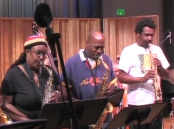 Early this month, I made my first-ever trip to the UK, visiting London on business. There wasn’t much time to get around, especially considering we were near the London ExCel conference facility, well to the east of anything in London that I’d heard of.
Early this month, I made my first-ever trip to the UK, visiting London on business. There wasn’t much time to get around, especially considering we were near the London ExCel conference facility, well to the east of anything in London that I’d heard of.
But I did sneak out on my final night to visit the Vortex Jazz Club, a cozy second-story music space and bar that’s been a cornerstone of creative jazz worldwide. Saxophone legend Evan Parker performs there once a month on a kind of permanent residency.
Cafe Oto, nearby, also features plenty of experimental music, but I had only one evening available. The Markov Chain, a piano-bass-drums combo of improvised jazz, won out.
Both venues are in the neighborhood of Dalston, one of those formerly low-rent areas where ethnic foods and skateboarders collide with redevelopment money and hipsters. The area has that city grime to it, and the surface similarities to Manhattan’s Lower East Side were actually a little comforting.
 The Vortex itself is off the main drag, in a small plaza that’s now named Aim Bailey Place after Derek Bailey. The shot at left, from the Hackney Hive site, gives you a pretty good impression.
The Vortex itself is off the main drag, in a small plaza that’s now named Aim Bailey Place after Derek Bailey. The shot at left, from the Hackney Hive site, gives you a pretty good impression.
It’s a friendly place where they didn’t mind that I wasn’t drinking alcohol that night. (I honestly felt bad about that and contributed to the till via multiple mineral waters and couple bags of crisps.) The place filled up by showtime — many attendees being friends of the band, certainly, but not all. I wasn’t the only one who’d staked out a table early, and music fans’ reservations filled out the front row.
The Markov Chain is a free improvisation group that infuses plenty of jazz idiom into their playing — although extended technique did show up a bit during the show, particularly with bassist Tim Fairhall.
Pianist and bandleader Adam Fairhall (Tim’s brother) has had a couple of other projects out, including The Imaginary Delta, a septet suite released by Slam Productions. Possibly the best known member of the trio is drummer Paul Hession, who’s recorded frequently for Slam and Bruce’s Fingers — the latter having also put out The Markov Chain’s eponymous CD.
 The show at the Vortex started with Adam Fairhall doing a solo piano piece lasting maybe 20 minutes. It was a stunning mashup of old and new jazz styles, bursting with references to boogie-woogie and ragtime. Lots of blues colors, and some near-classical, concert-hall-style jazz, and sprinklings of free improv.
The show at the Vortex started with Adam Fairhall doing a solo piano piece lasting maybe 20 minutes. It was a stunning mashup of old and new jazz styles, bursting with references to boogie-woogie and ragtime. Lots of blues colors, and some near-classical, concert-hall-style jazz, and sprinklings of free improv.
One particularly memorable stretch built off of a rolling 6/8 boogie-woogie theme in the bassline, with right-hand playing that was tonal and massive, built from fistfuls of chords.
After a break, the Markov Chain played two pieces — a long improvisation tracking maybe 40 minutes, and a 10-minute “encore” piece.
The longer piece was an exercise in sustained energy — not one solid wall of music, but a fast-paced series of episodes. I don’t recall any long quiet stretches, although there were plenty of passages where one player dropped out, leaving the other two in an extended duet.
Hessian is an excellent drummer, a whirlwind with a feather touch. And Tim Fairhall was captivating on bass — lots of pizzicato with big intervallic leaps, and later, a string-mashing bowing style.
The 10-minute followup stared in a mode crystalline and careful, one of the few settings they hadn’t explored in the longer piece.
I liked these guys. I’ve been enjoying their CD, where every track is an anagram of The Markov Chain. (“Monk Crave Hi Hat” is a particularly catchy title.) I was exhausted from the work week, but I was glad to see the Vortex and to experience this music. I’m rarely unhappy after I’ve taken the extra effort to go find out what’s out there.
 1. Lucia Iannello — Maintenant (Slam, 2015)
1. Lucia Iannello — Maintenant (Slam, 2015) 2. Jesse Sharps Quintet & P.A.P.A. — Sharps and Flats (Nimbus West, 2005)
2. Jesse Sharps Quintet & P.A.P.A. — Sharps and Flats (Nimbus West, 2005) 3. The Gathering
3. The Gathering 4. Mimi Melnick’s liner notes
4. Mimi Melnick’s liner notes 5. Nimbus West
5. Nimbus West The Kickstarter for
The Kickstarter for  With only a few days left, the Kickstarter for the film
With only a few days left, the Kickstarter for the film